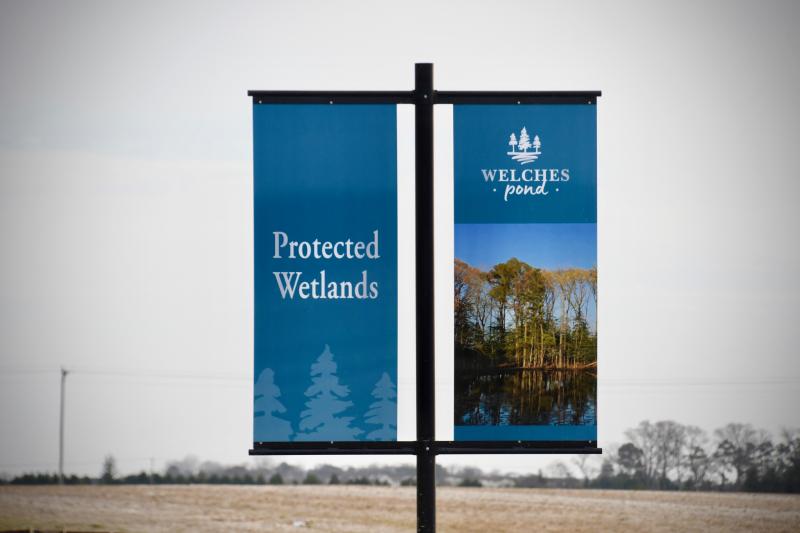Sussex officials debate changes to buffer ordinance
There will be changes to the new wetlands buffer and drainage ordinance; many of which were recommended by citizens testifying during public hearings.
It's against county code to do any trim work or tree cutting in buffer areas. With proposed changes to the ordinance, county officials would have strict enforcement measures to ensure those areas are left undisturbed.
At its March 22 meeting, Sussex County Council discussed the proposed changes as presented by County Administrator Todd Lawson.
Among the key recommendations are modifications to controversial Section 10G of the ordinance pertaining to options in buffers and a new section devoted to enforcement, including fines and penalties for disturbing buffer areas. In addition, the ordinance now includes provisions for signs or monuments delineating buffers.
The violation section is divided into development and post-development stages with fines and penalties for both sections.
Lawson said about 90 percent of the proposed ordinance has been agreed to as written. He added that some provisions, mostly those in Section 10G pertaining to options, generated a lot of discussion and questions from council. “The section was written to allow flexibility with incentives to keep trees in place,” Lawson said.
Although staff is not recommending complete removal of the section, proposed changes would reduce the scope of options substantially, Lawson said.
Under the proposed changes, no options would be available in tidal and non-tidal wetlands, but would be allowed in areas with perennial streams, non-tidal rivers and streams and non-tidal wetlands and intermittent streams.
In the Zone A areas of buffers, those closest to a resource, no options would be available, but limited options would be available in Zone B areas.
Post-construction regs
During the discussion about the enforcement section, council members questioned the proposed fine structure for the post-development phase when buffer maintenance has been turned over to homeowners associations.
Under the proposal in the post-development phase, violators would be fined $500 per square footage of a disturbed area and rehabilitation of the area must be at a 3-1 ratio for replantings.
By county code, any construction or trimming is prohibited in buffers, which are considered by the county and Sussex County Conservation District as areas not be disturbed.
Yet, Lawson said violations are commonplace. Selective clearing in buffer areas by homeowners – and sometimes HOAs – is an ongoing issue, which the new ordinance would address, he said.
“In numerous subdivisions, we deal with acts by homeowners who want to improve their view. They don't come to us or their HOA. It's not allowed today and needs to stop tomorrow,” he said.
Councilman John Rieley said the ordinance should include provisions to dissuade people from clearing out brush, trimming limbs or cutting down trees in buffers. “It should hurt, but not crush somebody,” he said. “The fine should be capped or progressive. I shudder to think that someone clearing out brush would end up in deep water financially. We need a measured response.”
He said a homeowner or HOA could be hit with a six-figure fine if a large area is disturbed. Rieley also said mistakes are made by homeowners who may not be aware where their property line ends and a buffer begins.
Lawson said the sign provisions would make it clear where areas of no disturbance are located.
He said staff would look at changing the fine to institute a cap and also look at a progressive scale for ongoing violations.
Lawson said the changes would be incorporated into a new draft to be presented to council during a future meeting.
Construction-phase regs
Council members agreed with the proposed fines and penalties proposed for violations during the construction phase of a project.
Councilman Doug Hudson said with GPS technology available today, there are no excuses for workers to cut down trees in buffers. “Asking for forgiveness, I'm done with that,” he said.
“If there are not teeth in the ordinance, people will continue to do what they have been doing. We have very limited options today and no fines,” Lawson said.
Developers or property owners face a fine of $1,000 per square foot if an off-limits area is disturbed. In addition, the disturbed area must be replanted and rehabilitated and the developer or property owner must also purchase existing natural forest in the same area by securing a conservation easement equal to 10 times the area of disturbance. For areas 100 square feet and less, the fine is $500 per square foot.
Also, no building permits would be issued until fines are paid and rehabilitation work is complete.
“This has to be of a magnitude to get developers' attention to not make mistakes,” Lawson said.
“I hear it's cheaper to destroy an area and pay the fine,” said Councilman Mark Schaeffer.
County engineer Hans Medlarz said that is not the case with the new regulations where fines could be six figures. Even a relatively small area of 200 square feet of disturbance would result in a $200,000 fine.
Lawson said that developers will have to get used to installing silt fencing around buffer areas.
Medlarz said during pre-construction meetings, it will be made clear where no-disturbance areas are located, and those areas are included on final site plans. In addition, he said, developers will be made aware of the penalty section in the ordinance.
Lawson said developers will be informed of the new ordinance in person once it’s adopted.
Any decisions made by staff can be appealed to council, Lawson said.
County assistant attorney Vince Robertson said court action would be necessary if fines or penalties are not forthcoming.
Other proposed changes
Other suggestions include: Changes in verbiage to define forests as existing natural forest areas; areas preserved with conservation easements cannot be farmed; letters of credit or bonds would be required for buffer areas; clearer verbiage for HOAs pertaining to restrictive covenants to ensure the new ordinance is included; and no buffers would be permitted in dry or wet stormwater ponds in either zone.
Under the proposed changes, walking trails through a buffer to reach a resource area would be permitted in Zone A and Zone B. However, parallel trails along buffers would only be permitted in Zone B and not the area closest to a resource being protected.
Medlarz noted that trails constructed of pervious materials are recommended because trails with impervious materials, such as asphalt, fall under stormwater management regulations. “There is a strong deterrent not make the trails impervious,” he said.
The changes also include a requirement for signs to be posted to delineate buffer areas where disturbance is prohibited, which is not the case today. Lawson said the size of the signs and placement can be determined by staff.
Lawson said although several people suggested that the ordinance be enacted as soon as its approved, he said a more realistic time frame would be three to six months.























































